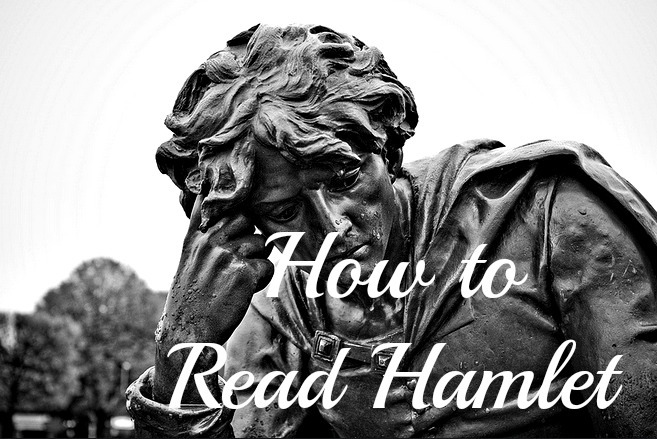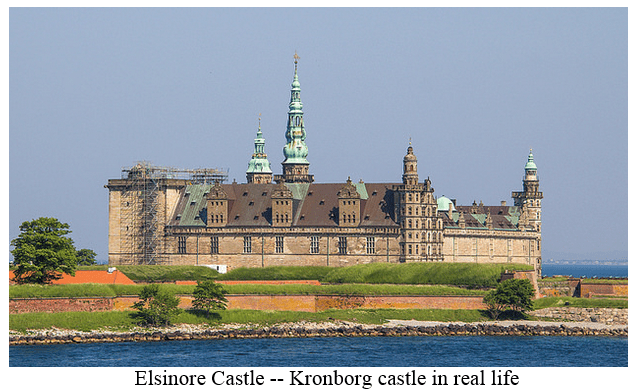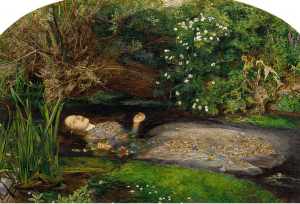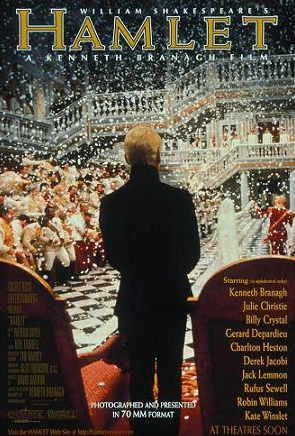
Hamlet is often considered to be the best work of English-language literature.
This year marks the 400th anniversary of the death of William Shakespeare (1564 – 1616) — the Bard of Avon.
Born in Stratford-upon-Avon in Warwickshire, England, Shakespeare was the son of a glover. Although he only attended school until the age of 15, he went on to become one of the world’s best-known playwrights. His career spanned the reigns of two monarchs: Queen Elizabeth I and King James I.
 Shakespeare wrote 37 plays, including tragedies, histories, and comedies. These ten plays are generally considered to be his best works:
Shakespeare wrote 37 plays, including tragedies, histories, and comedies. These ten plays are generally considered to be his best works:
- Hamlet
- Macbeth
- King Lear
- The Tempest
- A Midsummer Night’s Dream
- Twelfth Night
- Henry IV, Part 1
- Henry V
- Othello
- Romeo and Juliet
Hamlet was written toward the later part of Shakespeare’s life and career. The character of Hamlet was written for Richard Burbage, the leading tragedian of Shakespeare’s time and a member of Shakespeare’s company of actors, The Lord Chamberlain’s Men (later, The King’s Men).
The play’s theatrical success and popularity has continued unabated since its first performances in the early 1600s.
Hamlet – A Synopsis
The Tragedy of Hamlet, Prince of Denmark (often shortened to “Hamlet”) is set in the town of Elsinore in the Kingdom of Denmark during the late Middle Ages. Most of the action takes place in and around Elsinore Castle.

Near the beginning of the play, Prince Hamlet is visited by the ghost of his father, King Hamlet, who has recently died. The ghost instructs Hamlet to seek revenge for his murder. The king was killed by his brother, Claudius, who then married King Hamlet’s widow—Queen Gertrude—and seized the throne.
Here’s a clip from Act I, Scene 5, showing the ghost of King Hamlet telling the prince how he died and ordering Hamlet to avenge his death:
Although Hamlet becomes obsessed with avenging his father’s death, he hesitates, and keeps brooding and philosophizing. He tries to justify why he should wait before killing Claudius. At first he tells himself that perhaps what he saw wasn’t the ghost of his father after all, but an evil spirit trying to lead him astray.
Hamlet is torn. He wants to take the time to act reasonably, but he also chastises himself for being indecisive and failing to act boldly. Some critics believe that Hamlet is being prudent by taking steps to gather evidence of Claudius’ guilt before he acts. Other critics believe that Hamlet’s tragic flaw is his inaction.
Hamlet was already moody and disgruntled before his father’s ghost appears to him—after all, his father had recently died and his mother had remarried before his body was cold in the ground. After talking to the ghost, Hamlet begins to act even more strangely.
Queen Gertrude and King Claudius begin to worry about Hamlet’s inability to shake off his melancholy mood, and they both encourage Hamlet to get over his grief. However, Claudius starts to suspect that there may be something more to Hamlet’s moodiness than simply sadness over the death of his father.
Soon, suspicion turns to fear, and Claudius concludes that Hamlet may be a threat to him. He recruits spies to try to uncover what Hamlet is up to, starting with Polonius, chief counselor of the king. Later he also convinces Rosencrantz and Guildenstern, childhood friends of Hamlet, to spy on Hamlet and report back to him.
When Hamlet realizes that Claudius sees him as a threat, he begins to act as if he’s gone mad in order to throw off his uncle’s suspicions. Hamlet feigns madness with his family and friends, including his beloved, Ophelia, daughter to Polonius and sister to Laertes.
Hamlet decides to set a trap for Claudius to try to determine his guilt. A group of actors is going to put on a play for the royal court. Hamlet meets with the actors and instructs them to put on a play about regicide.
The play is to be about a king who falls asleep in his garden, and then another man kills him by pouring poison in his ear. That is, exactly what the ghost told Hamlet that Claudius had done.
Hamlet tells his loyal friend, Horatio, about his plan. He’s going to watch Claudius carefully during the play to see if he reacts suspiciously, and he asks Horatio to do the same. Although the name of the play is The Murder of Gonzago, Hamlet refers to it as The Mousetrap.
At the play, Claudius becomes enraged and screams for more light. Hamlet and Horatio agree that the king’s behavior is telling. Hamlet is now convinced that the ghost was telling the truth and that Claudius is a murderer. He realizes that he must act and kill his uncle.
Here’s the scene of The Mousetrap and Claudius’ reaction to the play (Act III, Scene 2):
Shortly after watching the play, Claudius is alone and, in a soliloquy, he expresses his guilt and grief over having killed his brother. However, he is unwilling to give up the things he gained by committing the murder, namely, the throne and the queen. He falls to his knees and begins to pray.
As Claudius is praying, Hamlet walks by and sees him. This is a golden opportunity to kill Claudius. And yet, once again, Hamlet hesitates.
Hamlet tells himself that if he kills Claudius while he’s praying, his soul will go directly to heaven. In the meantime, his father’s ghost was in purgatory since he did not have the chance to go to confession before dying. Hamlet wants Claudius to go to hell, so he leaves without killing Claudius.
Here’s the scene (Act III, Scene3):
After leaving Claudius in prayer, Hamlet goes to his mother’s chambers to confront her. However, Polonius is already there talking to the queen. When Polonius hears Hamlet approaching, he quickly hides behind a tapestry so that he can eavesdrop on the conversation between Hamlet and the queen.
Once in the queen’s chambers, Hamlet accuses his mother of having betrayed his father’s memory by marrying Claudius. He’s irate and menacing. At one point, the queen fears that he’s going to kill her. She cries out for help and foolish Polonius echoes her cry from behind the tapestry.
Hamlet rashly concludes that it’s Claudius hiding behind the tapestry. He lunges at the hidden figure and stabs it forcefully with his sword, thus killing Polonius. The dead Polonius rolls out from under the tapestry.
When Hamlet finally acts, he doesn’t do so in a reasonable, effective, and purposeful manner. Instead, he does so blindly, recklessly, and violently. Here’s the scene (Act III, Scene 4):
Ophelia is the only woman in the play in addition to Queen Gertrude. Hamlet was at one time sincerely in love with Ophelia. However, the circumstances that Hamlet finds himself in lead him to start feeling unsympathetic toward her.
Hamlet transfers the anger that he feels toward his mother—whom he concludes is a woman of loose morals—to all women, including the pure and virtuous Ophelia. He pushes Ophelia away and tells her to join a nunnery.
The death of Ophelia’s father, Polonius, added to her heartbreak over Hamlet’s rejection is too much for Ophelia to bear. She goes mad, throws herself into a river, and drowns.

In the meantime, Denmark is under threat of attack from Norway. Fortinbras, Prince of Norway, wants to avenge his father’s death. His father, King Fortinbras of Norway, was killed by Hamlet’s father. King Hamlet killed King Fortinbras in hand-to-hand combat, thus winning lands from Norway.
Fortinbras wants to avenge his father’s death, and he wants to retake the lands that Norway lost to Denmark. There are many parallels between Fortinbras and Hamlet:
- They both lose their fathers.
- In both cases, their uncles took over the throne.
- They both want to avenge their fathers’ deaths.
However, their characters are very different. While Hamlet is hesitant and indecisive, Fortinbras is bold and resolved. Fortinbras’ strong-willed character serves to highlight Hamlet’s tragic flaw.
While this threat looms from Norway, the Danish royal house is in disarray. Claudius has become aware that Hamlet knows about the circumstances of his father’s death, and he wants Hamlet dead.
Laertes has returned to Denmark from France to avenge the death of his father, Polonius. He returns to Elsinore with a mob, threatening to overthrow Claudius if he doesn’t explain his father’s murder. Claudius tells him that it was Hamlet who killed Polonius, and the two men devise a plot to kill Hamlet. Like Fortinbras, Laertes is a man of action.
Claudius and Laertes decide that Laertes will challenge Hamlet to a friendly duel. However, Laertes’ sword will be poisoned. If Laertes draws blood, Hamlet will die.
As a backup plan, Claudius puts poison in a goblet filled with wine. If Laertes fails to poison Hamlet with his blade, then Claudius will offer Hamlet a drink from the poisoned goblet. Here’s what happens during the fencing match between Hamlet and Laertes:
- Queen Gertrude ends up drinking from the poisoned goblet, and dies. It’s debatable whether she does this by accident, or in an attempt to prevent her son from drinking the poison.
- Laertes succeeds in wounding Hamlet with his sword, but Hamlet doesn’t die of the poison immediately.
- Laertes is cut by his own poisoned sword and dies.
- Hamlet stabs Claudius with the poisoned sword and forces him to drink the rest of the poisoned wine, thereby killing him.
- Hamlet dies immediately after achieving his revenge.
At this point, Prince Fortinbras, who has led an army to Denmark, enters Elsinore Castle. When he sees that the entire Danish royal family is dead, he takes power over the Kingdom of Denmark.
The Original Hamlet
As was common in his day, Shakespeare based many of his plays on the work of other playwrights and recycled older stories and historical material. This is true of his play Hamlet. The story of Hamlet dates back to at least the 9th century.
It centers on a young prince named Amleth who fakes being crazy in order to avenge his father’s murder. Saxo the Grammarian included the tale in a 12th century text. Later, François de Belleforest incorporated the story in his Histoires Tragiques, which is where Shakespeare may have found it.
Film Adaptations of Hamlet
First performed in 1602, Hamlet is Shakespeare’s longest play, and his most famous. It’s been performed countless times and many movie adaptations of the play have been made. Here are seven of the most famous film adaptations of “Hamlet”:
1. Kenneth Branagh’s Hamlet: This is a 1996 film adaptation of Hamlet, adapted for the screen and directed by Kenneth Branagh, who also stars in the titular role as Prince Hamlet. The film features a star studded cast, including Derek Jacobi as King Claudius and Kate Winslet as Ophelia.
2. Laurence Olivier’s Hamlet: This is a 1948 film adaptation of Hamlet, adapted and directed by and starring Sir Laurence Olivier. Although the film has received many prestigious accolades, it cut out nearly two hours worth of content.
3. Mel Gibson’s Hamlet: This is a 1990 film adaptation of Hamlet, directed by Franco Zeffirelli and starring Mel Gibson as Hamlet. The film also features Glenn Close as Queen Gertrude.
4. David Tennant’s Hamlet: This is a 2009 television film adaptation of the Royal Shakespeare Company’s 2008 modern-dress stage production of Hamlet. It features David Tennant in the title role of Prince Hamlet and Patrick Stewart as King Claudius.
5. Ethan Hawke’s Hamlet: This is a 2000 adaptation of Hamlet, which is set in contemporary New York City. Ethan Hawke plays Hamlet as a film student. Elsinore Castle is re-imagined as Hotel Elsinore, the headquarters of Denmark Corporation.
6. Derek Jacobi’s Hamlet: This is a 1980 television adaptation of Hamlet done by the British Broadcasting Company (BBC). It stars Derek Jacobi as Hamlet.
7. Richard Burton’s Hamlet: This is not really a film, but a recording of an actual Broadway performance. It played from April 9 to August 8, 1964 at the Lunt-Fontanne Theater, and stars Richard Burton as Hamlet.

Another famous adaptations of Hamlet–although this one took a lot of creative liberties–is Disney’s “The Lion King”. Look at the following:
- Scar–like Claudius–kills his brother and takes over as ruler of the Pride Lands.
- Simba–like Hamlet–gets visited by the ghost of his father, Mufasa.
- Mufasa, of course, is like King Hamlet.
- Timon and Pumbaa share similarities with Hamlet’s childhood friends, Rosencrantz and Guildenstern.

How to Read Hamlet – 10 Steps
Here are ten steps to reading, understanding, and enjoying Hamlet:
1. Read a Plot Synopsis. Before you sit down to read Hamlet, you should read a synopsis of the play. I provide one above, but you may want to do your own research and find a synopsis that you like. There are two books that I used for this purpose:
- Asimov’s Guide to Shakespeare: A Guide to Understanding and Enjoying the Works of Shakespeare
- Shakespeare A to Z: The Essential Reference to His Plays, His Poems, His Life and Times, and More
There are also many good synopses available online. These include SparkNotes, Shmoop, and eNotes.com.
In addition to reading a synopsis of the entire play before getting started, read a synopsis of each scene before reading that scene.
2. Choose a Good Annotated Edition. Although Shakespeare wrote in Modern English, you probably won’t understand his plays unless you get an annotated version. Shakespeare uses some syntax and words that we don’t use anymore. In addition, he makes references to historical events that only people of his time would have understood.
Annotated texts provide definitions, context, and value-added information that will allow you to understand what’s going on in the play. Here are three popular annotated editions of Hamlet you can choose from:
- Hamlet ( Folger Library Shakespeare) — this is the one I have, and would recommend.
- Hamlet: Revised Edition (The Arden Shakespeare Third Series) — many believe Arden Shakespeare to be the definitive critical edition of Shakespeare.
- Hamlet (No Fear Shakespeare) — No Fear Shakespeare puts Shakespeare’s language on one page, and then it places the same text translated into contemporary English on the facing-page.
3. Read Slowly and Carefully. Read each page once without referring to the annotations. Simply enjoy Shakespeare’s incredibly beautiful and vivid use of the language. You may even want to read it out loud. Then, read the page again, but this time refer to the annotations. Continue in this way until you’ve read the whole scene.
4. Watch the BBC’s Hamlet. After you’re done with each scene, watch the BBC’s Hamlet for that scene. The BBC Television Shakespeare is a series of British television adaptations of the 37 plays of William Shakespeare.
The BBC uses fantastic actors, and their adaptations closely follow the original material. Derek Jacobi plays “Hamlet” in the BBC’s version of the play, and many consider him to be the best actor to have played the role. In addition, Patrick Stewart plays Claudius.
5. Take Notes. After you’ve read and watched each scene, write down a short synopsis of the scene. This will help you to make sure that you understood what you just read and saw, and it will help you to retain it. Also, you’ll have something to refer to later on when the play is no longer fresh in your mind.
Here are some things you may want to jot down:
- A summary of the scene.
- Your impressions of the scene.
- Anything you noticed about the characters that appeared in the scene.
- Themes–mortality, action, madness, lies and deceit–and subplots that were present in the scene.
- Note how the scene moves the main plot of revenge along.
- Note any life lessons in the scene (Shakespeare’s plays are filled with life lessons).
In addition, write down any quotes that caught your fancy. Here are some of the most famous quotes from Hamlet:
“Neither a borrower nor a lender be;
For loan oft loses both itself and friend,
And borrowing dulls the edge of husbandry.
This above all: to thine ownself be true,
And it must follow, as the night the day,
Thou canst not then be false to any man.”“Frailty, thy name is woman.”
“Something is rotten in the state of Denmark.”
“There is nothing either good or bad, but thinking makes it so.”
“There are more things in Heaven and Earth, Horatio, than are dreamt of in your philosophy.”
“Though this be madness, yet there is method in’t.”
6. Find Additional Material. Pick a couple of critical or scholarly works on Shakespeare’s plays, and on Hamlet in particular. Going through this material will give you a greater understanding of the play, and it will provide you with different viewpoints and interpretations.
Here are some good sources you can choose from:
- Shakespeare After All by Marjorie Garber
- The Meaning of Shakespeare, Volume 1 by Harold C. Goddard
- Shakespeare: The Invention of the Human by Harold Bloom
- Shakespearean Tragedy: Lectures on Hamlet, Othello, King Lear, and Macbeth by A.C. Bradley
- What Happens in Hamlet by J. Dover Wilson
Another option is to take a MOOC on Hamlet, such as Shakespeare’s Hamlet: Text, Performance and Culture, which is free (I enrolled for this MOOC, but they haven’t told us when it starts yet).
7. Read the Play Again. Read the play again, from start to finish. You should be familiar enough with the play by this point that you don’t need to refer to the annotations or look at any additional reference material.
8. Watch Another Film Version. I gave you a list of seven excellent film versions of Hamlet above, including the BBC version which you should have been watching as you read the play. Now you’re going to choose another film adaptation of Hamlet and watch it from beginning to end.
In case you’re wondering, I chose to watch Branagh’s version of Hamlet (and loved it). It’s unabridged and runs just over four hours. The play’s setting is updated to the 19th century, but everything else is true to the original.
9. Consider Memorizing a Soliloquy. There are several famous soliloquies in Hamlet, including the most famous one, “To be, or not to be”.
Many critics believe that this soliloquy is a contemplation of suicide. In it, Hamlet compares death to sleep. The catch is that it could be a sleep filled with bad dreams. Here’s Jacobi reciting the soliloquy:
Memorize the soliloquy, and then proceed to amaze your friends at cocktail parties.
10. Watch Hamlet on Stage. Reading Hamlet, watching film adaptations of Hamlet, and reading scholarly works about Hamlet are fantastic ways to make this fabulous work your own. However, Hamlet is a play, and to truly appreciate it you should watch it performed on stage.
Bonus points if you watch the play at Stratford-upon-Avon, or at the Shakespeare’s Globe in London.
Conclusion
If you haven’t read Hamlet, use the fact that 2016 marks the 400th anniversary of the bard’s death to do so. And if you have read it, read it again. Live your best life by reading Shakespeare’s plays.





Related Posts:




 Marelisa Fabrega is a lawyer and entrepreneur. She holds a Bachelor of Science in Business Administration from Georgetown University in Washington, D.C., as well as a Juris Doctor from the Georgetown University Law Center. You can learn more about her
Marelisa Fabrega is a lawyer and entrepreneur. She holds a Bachelor of Science in Business Administration from Georgetown University in Washington, D.C., as well as a Juris Doctor from the Georgetown University Law Center. You can learn more about her 





